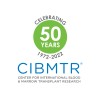Clinical Transplant-Related Long-term Outcomes of Alternative Donor Allogeneic Transplantation (BMT CTN 1702) (BMT CTN 1702)
Acute Myeloid Leukemia, Acute Lymphoblastic Leukemia, Myelodysplastic Syndromes

About this trial
This is an interventional treatment trial for Acute Myeloid Leukemia
Eligibility Criteria
Inclusion Criteria:
Patients fulfilling the inclusion criteria will be eligible for enrollment in this study. Of those who consent, only patients who lack a suitable HLA-identical or 1 allele or antigen mismatched related donors are evaluable. Patients with an HLA-identical sibling or 1 allele or antigen mismatched family member donor are evaluable as long as the center deems the family member donor as unsuitable for other reasons. Patients may co-enroll with other interventional or observational studies.
- Patients of all ages with AML, ALL, MDS, NHL, HL, AA, or SCD are eligible.
- Any planned conditioning regimen and GVHD prophylaxis approach is eligible.
- Patients must be considered suitable allogeneic transplant candidates at the time of enrollment based on medical history, physical examination, and available laboratory tests. Specific testing for organ function is not required for eligibility but, if available, these tests should be used by the treating physician to judge transplant suitability.
- Patient and physician must intend to proceed with allogeneic HCT within the next 6 months if a suitable donor is identified.
- Center plans to follow the algorithm for alternative donor identification: (a) for subjects who are Very Likely to find a MUD, attempt to identify a matched unrelated donor; (b) for a subjects who are Very Unlikely to find a MUD, proceed expeditiously to a haploidentical, cord blood or mismatched unrelated donor.
- Signed informed consent, and assent if applicable. Consent may be signed prior to completion of family typing but patients will only be considered evaluable upon confirmation that there is no suitable HLA-identical or 1 allele or antigen mismatched related donor available.
Exclusion Criteria:
- Prior allogeneic HCT (prior autologous transplant is allowed)
- Previous formal unrelated donor search
Sites / Locations
- City of Hope
- University of California, San Diego Medical Center
- Children's Hospital Los Angeles
- Stanford Hospitals and Clinics
- Children's National Medical Center
- University of Florida
- University of Miami
- Memorial Healthcare System
- H. Lee Moffitt Cancer Center
- Children's Healthcare of Atlanta
- Emory University
- Northside Hospital
- Loyola University
- Indiana University
- University of Maryland
- Dana Farber Cancer Institute
- University of Michigan
- Karmanos Cancer Institute
- University of Minnesota
- Mayo Clinic Rochester
- University of Mississippi
- Children's Mercy Hospital
- St. Louis Children's Hospital
- Washington University in St. Louis
- University of Nebraska Medical Center - Adults
- University of Nebraska Medical Center - Pediatrics
- Rosewell Park Cancer Institute
- Mount Sinai Medical Center
- Memorial Sloan Kettering Cancer Center
- University of North Carolina
- Levine Cancer Institute
- Duke University Medical Center
- Wake Forest Baptist Health
- University Hospitals Cleveland Medical Center
- Cleveland Clinic
- Nationwide Children's Hospital
- The Ohio State University
- University of Oklahoma
- Oregon Health and Science University
- Children's Hospital of Philadelphia
- University of Pennsylvania
- Medical University of South Carolina
- Children's Medical Center Dallas
- Cook Children's Medical Center
- Baylor College of Medicine
- M.D. Anderson Cancer Center
- University of Utah
- University of Virginia
- Virginia Commonwealth University
- Fred Hutchinson Cancer Research Center
- University of Wisconsin
- Medical College of Wisconsin
Arms of the Study
Arm 1
Arm 2
Arm 3
Other
Other
Other
Donor Search Prognosis: MUD Very Likely
Donor Search Prognosis: MUD Very Unlikely
Donor Search Prognosis: MUD Less Likely
Patients who are Very Likely to find a matched unrelated donor (MUD), defined as having a >90% chance of finding an 8/8 HLA-matched unrelated donor, for whom a fully matched unrelated donor will be pursued.
Patients who are Very Unlikely to find a MUD, defined as having a <10% chance of finding an 8/8 HLA-matched unrelated donor, for whom a haploidentical, cord blood, or mismatched unrelated donor transplant will be pursued.
Patients with a Less Likely chance of finding a MUD, i.e., those not falling into the other two groups (a 26% chance), will be enrolled onto the observational component of the study and analyzed for all relevant endpoints but will not be included in the primary comparison.
Outcomes
Primary Outcome Measures
Secondary Outcome Measures
Full Information
1. Study Identification
2. Study Status
3. Sponsor/Collaborators
4. Oversight
5. Study Description
6. Conditions and Keywords
7. Study Design
8. Arms, Groups, and Interventions
10. Eligibility
12. IPD Sharing Statement
Learn more about this trial
